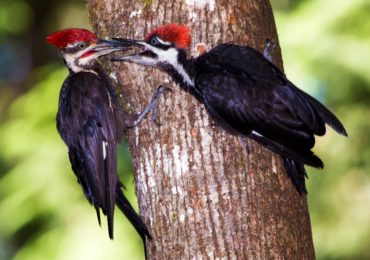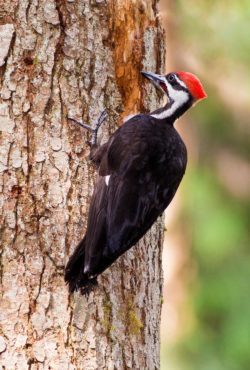
When it comes to majestic birds, people often think of bald eagles and trumpeter swans. But would anyone call a woodpecker majestic?
The 1800s and early 1900s were a period of unprecedented destruction across North America. Colossal forests were completely decimated to harvest timber and farm the land. Having lost their habitat, the world’s two largest woodpeckers were unfortunate casualties of this devastation.
By the mid-20th century, the massive, 24-inch-long imperial woodpecker of Mexico and its slightly smaller cousin, the iconic, ivory-billed woodpecker of the southeastern United States, had become extinct.
Now a chapter in American history, the ivory-billed woodpecker was so majestic that upon seeing one, people would exclaim, “Lord God, what a bird!”
In 2004, reports of a rediscovery in an Arkansas swamp of the “Lord God bird,” as President Theodore Roosevelt called it, took the birding world by storm. But despite intensive searches of suitable habitat, the alleged sighting was never confirmed. Sadly, the ivory-billed woodpecker is gone forever.
Thankfully, one large North American woodpecker survived. With the help of designated protected forests and improved forestry practices, the pileated woodpecker, about two-thirds the size of an imperial woodpecker, continues to inhabit forests from the East Coast to the Gulf Coast, across southern Canada and along the West Coast.

Here in West Sound, the pileated woodpecker is a fairly common year-round resident that is often heard before being seen. With its powerful chisel bill, this large woodpecker strikes a tree with such force that it can sound like an axe. Males drum loudly on hard wood to attract females.
While its voice can sometimes be soft and whiny like a northern flicker, the pileated woodpecker’s famous, Tarzan-like call echoes through the forest, even startling indoor dogs into fits of barking.
Its unmistakable plumage makes identification easy. Males and females are both black, with white striping. Birds in flight show striking white underwings. Males sport a red “mustache” (called a malar stripe), which is black on females.
The trademark feature is the fiery red crest for which it is named. (Pileated derives from the Latin pileatus, meaning “capped” or “crested.”) The male’s crest extends down the forehead and the female’s crest resembles a pointy cap. A juvenile’s crest often stands straight up in a spiky, punk-rocker look.
In order to survive, mated pairs need a territory of more than 1,000 acres (1.5 square miles) of mature forest with multiple dead trees (called snags) for nesting and foraging. In contrast, a song sparrow can make its living on a single acre.
A candidate for the Washington state endangered species list, the pileated woodpecker is always at risk of losing its habitat. About the size of a large crow, it requires trees large enough to accommodate a nest cavity no less than 18 inches wide, with an entrance hole up to 5 inches in diameter.
The pileated woodpecker has special anatomy that allows it to safely pound its head against a tree. Many of these blows are struck at a speed of 25 mph. Acting as a shock absorber, the skull has frontal bones that are folded at the base of the bill. It also has a larger brain case than other birds, so the brain is safely above the level of impact.
The pileated woodpecker’s barbed tongue is three times the length of its bill, allowing it to snake through a tree to snare unsuspecting carpenter ants and wood-boring beetles. When not probing a tree hole for a meal, the tongue is rolled up in the back of the head.
Pileated woodpeckers supplement their insect diet with nuts and berries. They also visit backyard suet feeders, providing opportunities for close viewing of this typically shy bird.
A pileated woodpecker pair excavates a new nest cavity every year. They usually raise three or four chicks. After spending nearly a month in the cozy nest, fledglings then stay with the parents for two or three months.
The empty cavities serve as vital nesting and roosting habitat for dozens of other birds and mammals, such as wood ducks, spotted owls, martens and fishers.
Since the forest ecosystem depends on it, the pileated woodpecker is considered a “keystone species.” Without it, many other cavity nesters would be in peril.
You can aid pileated woodpeckers by preserving large snags, which are often cut down for being unsightly or threatening structures. Leave snags as they stand or consider reducing the height of tall, dangerous ones to 20 feet.
In North America, the pileated woodpecker is the last of its kind. If it disappears, the forests would lose an icon. And many other species may vanish with it.
The hourglass for the imperial and ivory-billed woodpeckers is empty. But the pileated woodpecker’s hourglass still has sand. Let’s ensure that it never runs out.



























